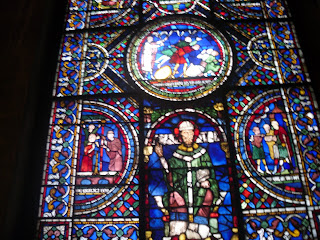Although this blog will be lacking in actual analytical text, the pictures below will be used again in later posts - there is a caption beneath and in the post following this one, I will compare certain aspects to other examples of Becket based artwork. As the starting point (and of course, the ending point) for any Becket research, a trip to Canterbury Cathedral was vital. Here's some of the pictures - apologies for any blurring!
This candle stand is just left of the memorial stone inlaid at the point
where Becket was murdered; I lit a candle (bottom right).
These swords have been in the Cathedral for a long time
and represent those used by the four knights who killed Becket - the broken one holding the
other three represents the one that physically broke Becket's skull.
Although this is an image of a sculpture done by Anthony Gormley, the
actual importance lies in its location with the Cathedral; it hovers approximately 15ft
above the first burial site of Becket's body - Gormley's reasoning behind the piece (made out of iron nails)
is 'Mind and body, church and state are polarities evoked by the life and death of Thomas Becket'.
This is proof that in 900 years, Becket's importance is as relevant as ever.
A small image of the Becket Miracle Windows - they were very high
and extremely detailed - the detail could not be captured in any image to the degree
you see in front of you.
Using flash on this image has highlighted the lead detailing - all of the
white and slightly grey areas are the lead. The lead we discovered (through a guide)
was applied first, by being poured onto the glass. The colour was then painted with a
particular kind of enamel. The South Facing window of the cathedral has had its most famous
saints windows removed for maintenance, and are showing two Saints periodically (During the visit, they were showing Methusela and Joseph) . We weren't allowed to take photos, but you can genuinely see the brush strokes.
Next to the Becket window is this painting based on the original manuscript image. The
date is far obviously later; the detail is developed, angle and dimension has been slightly incorporated
and most importantly, Becket is illustrated as a Saint.
Under the lettering is the arch of the doorway that the four knights
came through before killing Thomas. This lettering was added, and roughly translates to 'Tell us what is done with wonderful vestments. Blessed is the folly of the venerable St. Thomas shone with the urn in the bate of the martyr'. The original door is also still there, and it felt odd being able to touch such an important piece of English history.







No comments:
Post a Comment